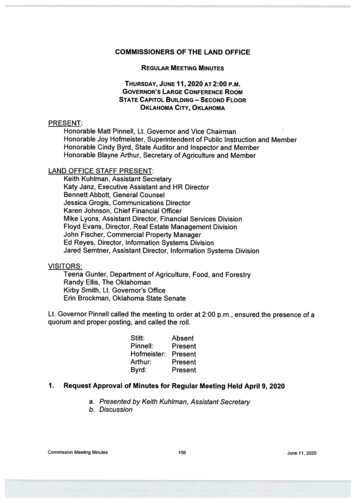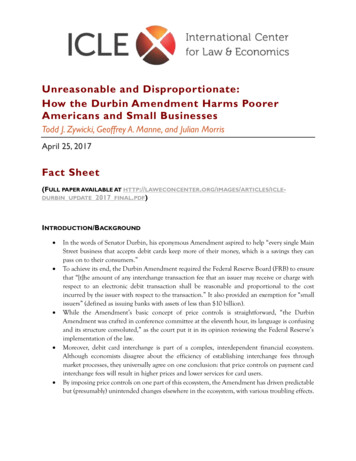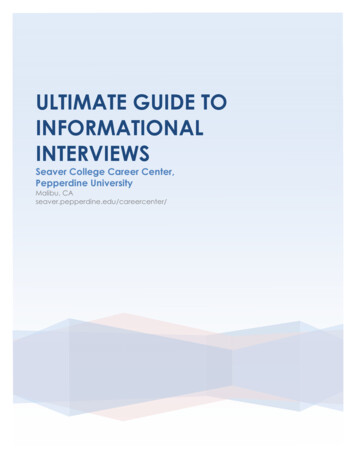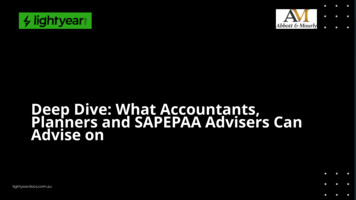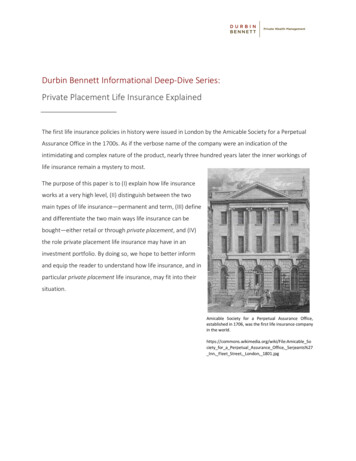
Transcription
Durbin Bennett Informational Deep-Dive Series:Private Placement Life Insurance ExplainedThe first life insurance policies in history were issued in London by the Amicable Society for a PerpetualAssurance Office in the 1700s. As if the verbose name of the company were an indication of theintimidating and complex nature of the product, nearly three hundred years later the inner workings oflife insurance remain a mystery to most.The purpose of this paper is to (I) explain how life insuranceworks at a very high level, (II) distinguish between the twomain types of life insurance—permanent and term, (III) defineand differentiate the two main ways life insurance can bebought—either retail or through private placement, and (IV)the role private placement life insurance may have in aninvestment portfolio. By doing so, we hope to better informand equip the reader to understand how life insurance, and inparticular private placement life insurance, may fit into theirsituation.Amicable Society for a Perpetual Assurance Office,established in 1706, was the first life insurance companyin the able Society for a Perpetual Assurance Office, Serjeants%27Inn, Fleet Street, London, 1801.jpg
I.Life Insurance BasicsThere is an old saying that life insurance is never bought, always sold. While this may be an overexaggeration, it is helpful for people to be aware of the true trade-offs involved in purchasing a policy.At its heart, life insurance is a simple concept: a contract in which you pay an insurance company(premiums) in exchange for some amount of money (death benefit) to be paid to your family if and whenyou pass away. You receive the most benefit from the insurance contract by passing away significantlybefore your life expectancy.The premiums—which are the amount you pay to the insurance company annually for the death benefit—depend on a few different factors that we’ve outlined below. Keep in mind that insurance companies arenot charities; any additional risk they take on leads to higher premiums for you. If you remember thisfundamental idea, it should help steer you away from any arrangements that appear to be too good to betrue.Factors that affect the amount of premiums you pay: Life Expectancy: If you are older, or in poorer health, there is a higher probability of you passingaway sooner. If you are younger and/or in better health, there is a lower probability. If we keep inmind that the insurance company is not an altruistic entity, then it follows that the older you areand/or the poorer health you are in, the higher the probability the insurance company will have topay your death benefit sooner, resulting in higher premiums. Death Benefit: The more death benefit you want to leave for your family, the higher thepremiums should be. For two people that are the same age and have the same life expectancy, ifperson A has a 1MM death benefit and person B has a 2MM death benefit, then we wouldexpect person B’s premiums to be approximately double what person A pays. The Length of Coverage: The longer you are covered for, the higher the premiums should be.Let’s say I have two different life insurance policies that I bought at the same time—one fromInsurance Company A that covers me for the next 10 years and the other from InsuranceCompany B that covers me for the next 20 years. Insurance Company B is covering me for twice2
as long. It has a higher probability that it will have to pay a death benefit and so will charge morefor the policy.These three factors make up the true cost of insurance. Said another way, if you were to start a nonprofit life insurance company and had enough people buy insurance from you, the premiums you chargedthem based on (1) their life expectancy, (2) size of death benefit, and (3) length of coverage wouldroughly equal the death benefits you had to pay out on an annual basis. However, life insurance is verymuch a for-profit enterprise. There are quite a few other fees that you don’t see in a policy whichcompensate the insurance agents (the people that sell you your policy) and insurance companies. Thetwo most prominent of these fees are as follows: Commissions: This fee is the dark horse of how much you have to pay in premiums. The moreyour insurance agent is making from the policy they sell you, the more you will pay in premiums.Remember that the insurance company is not doing you any favors for free. If they have to payyour agent more for the same policy, your premiums will go up to reimburse the insurancecompany for those commissions. Insurance Company Profits: Above the pure costs of insurance, the insurance company also layersin a profit margin. Sometimes this is in the form of an “M&E–mortality and expense—charge”.Other times it is impossible to tease out.In its most basic equation, the premiums you pay equal the true costs of insurance plus commissions toyour insurance agent and insurance company profit margin.3
Key PointsPremiums Cost of Insurance Agent Commissions Insurance Company Profit MarginIn our experience, it is helpful to understand who is making money off the insurance policy and in whatamounts. Life insurance is a very powerful tool given the right circumstances, but it is not the cure-all thatsome make it out to be. At the end of the next section, we’ll review some key questions to ask any lifeinsurance agent if and when you begin shopping for a policy.4
II.Permanent vs. Term Life InsuranceAs mentioned in the previous section, the length of time you are covered in a life insurance policy is a bigdeterminate of the overall cost of insurance. The insurance industry breaks down the length of coverageinto two main categories: Term and Permanent1. In term life insurance, you are paying premiums over aTerm life insurance is a less expensive form of insurance, but does not allowsetforamountof time premiums(usually at leastyears). Shouldyou passawaythatcontract.time period, your“surplus”nor10build-upof cashvalueininthebeneficiaries get a set death benefit. If you survive past the set amount of time, you get nothing. ForSample TermwillPolicypay a set premium each year for the next 10 years. That amount of money is made up of the costsexample, let’s say you are a 40 year old in good health and buy a 10 year term life insurance policy. Youdiscussed in the last section: insurance costs, insurance company profit spread, and sales agent costs. Ifyou are in good health, the likelihoodAnnualPremiumsInsurance Co.Profit SpreadAgentCostsInsuranceCosts(Death Benefit)you pass away before 50 should berelatively low. Therefore, the true costsof insuring your life should be low.The day you turn 50, all the premiumsyou paid essentially disappear.To continue to be covered with a deathbenefit, you will need to extend theFOR ILLUSTRATIONPURPOSES ONLY.term—which is like buying a new policy. Except this time, you will be 50 instead of 40. The likelihood of youpassing between 50 and 60 is higher, so the insurance costs should be higher. Between 60 and 70, it risesfaster still. At a certain point, the cost of insurance becomes prohibitive because the chances you pass away(let’s say after your life expectancy) become so hard for the insurance company to predict.What is the alternative if you want to be covered for a longer period of time—let’s say your entire life? Inthat case, there is an option for permanent life insurance instead of term.The main difference between permanent and term life insurance is that you are overfunding the trueinsurance costs in your early years to help pay for the more expensive insurance as you age. All theadditional complexities related to permanent life insurance stem from this one concept.1There is a permanent term option but this is not widely adopted.5
The cost or premiums have to be substantially higher for an insurance company to make a profit off ofyou even though they are certain to pay out a death benefit at some point in the future. For term policies,the instances they pay out a death benefit to, say, someone who is 45-years old are rare relative to howmany 45-year old individuals they have insured. In that case, the insurance premiums from the manyhealthy 45-year old individuals offset the few that pass away prematurely. The insurance company canstill make a profit and stay in business.With a permanent life insurance policy, the insurance company has to make a profit even though it istheoretically assured it will have to pay out a death benefit in an amount much higher than any one yearof premiums. They do this through charging higher premiums than are needed in the early years. Thissurplus is then invested and grows over time. That surplus—also called the policy’s cash value or cash4surrender value—then paysfor the highercosts of insurancetheis latteryears.Permanentlife insuranceis a policy inthatfundedthroughout an expectedlifespan with the potential for the build-up of cash value.This surplus is thesourceofmuchconfusion when lifeSample PermanentPolicy“Surplus”Premiumsinsurance is sold. Asyou build up moresurplusinyourAnnualPremiumsinsurance policy, youcreate an asset thatyou can access whileBuilt-upCashValueInsurance Co.Profit s(Death Benefit)Previous Years’“Surplus”Premiumsalive. For instance, ifFOR ILLUSTRATIONPURPOSES ONLY.you have been paying into a permanent policy for more than 10 years, chances are there is a “cashsurrender” value: the amount that you could get from the insurance company if you “sold” your policy backto them. That cash surrender value is usually far below the total amount of premiums you’ve paid in, but itstill has value. However, the longer you have a surplus and the better the investments it is in, the greateryour chances of having an asset worth more than the collective premiums you’ve paid. You can think of thisas similar to a Roth 401(k) or IRA account: after-tax dollars are put into an account and grow tax free overtime. The more time that passes, the more you save in taxes.Also similar to a retirement account, life insurance cash value grows tax free and is creditor protected inmany states, including Texas. The more surplus in a policy and the better the investments, the faster yourasset grows.6
Unlike a 401(k) account, though, the cash value can be accessed almost tax free. Every dollar of premiumyou pay can theoretically be withdrawn as a return of your basis. If you put 1MMM into a policy over tenyears and the cash value is worth 1.5MM, then you can hypothetically pull out 1MM without triggeringa taxable event. The remaining 500k cannot be withdrawn without triggering a taxable distribution thatwould be taxed at your ordinary income rate. However, you can take a loan out on a portion of the 500kthat would not trigger a taxable event. The loan would then be held on the insurance company’s books andwould be repaid out of the death benefit once you passed away. This is a powerful tool, provided that theinterest rate on your loan is low (which is much lower for private placement life insurance compared toretail accounts as will be discussed in the next section).The problem with most permanent policies is that there exists so much fee-drag in those early years thatthe surplus is small relative to amount of money you put into a policy. Consequently, these are also themost important years since the cost of insurance is the lowest; theoretically if you have more surplus inthe early years, the value will compound faster and higher. (Think about contributing more to a 401(k) inyour 20’s than in your 50’s.)What is the primary source of fee-drag in the early years of a policy? Sales agent commissions.Have you ever wondered why your life insurance agent wants to you to buy a larger permanent policy? Asa rule of thumb, a sales agent can make the equivalent of one full year of premiums (or more) incommissions when selling larger, permanent policies over shorter, term ones. Since the insurancecompany is not going to take a loss on those commissions, you ultimately are the one that pays them.This is the reason that a cash surrender value is lower than the amount you’ve spent on a policy in thefirst few years. If not for the sales agent’s commissions, your policy may be worth more than you investedin cash surrender value at the end of the first or second year, which in turn means that there would be alot more surplus premiums that would be invested.7
Key PointsTerm Pay premiums for set amount of time (10, 20 years) No Cash Surrender Value Less expensive premiums in early yearsPermanent Pay premiums over the course of your life. Access to Cash Surrender Value Overfunding premiums in early years to cover cost of insurance in later yearsUnderstand which is most appropriate for your situation by using the questions below.8
Questions to ask an insurance agent when shopping for a policy: Can you tell me all the ways you are compensated? What about this policy makes it particularly well-suited for my situation? Are thereless expensive policies that would accomplish the same overall goals? How flexible is this policy if I don’t need it in 10 or 20 years? What would yourecommend I do if I didn’t need the policy any more? I want to get a good understanding of how your commissions are structured. Canyou walk me through that so I understand it?oOver what period of time would you be paid for selling me this policy andhow exactly would those commissions be calculated?oHow much more do you get paid for selling me a larger death benefit orpermanent policy? Is it linear (e.g., twice the payout for twice the deathbenefit) or a larger increase? What are the total estimated charges in the policy over the first five years? Pleaselist a dollar value. What annual return would I have to make in a taxable investment account tomatch the return you are modeling out over the next 10 and 20 years?o Please list for both the projection and minimum guaranteed value.Has the insurance company ever raised their cost of insurance? If so, am I at risk ofhaving that happen in my policy? What is the “charge” if I were to borrow a loan from my policy?9
III.Retail vs. Private Placement Life InsuranceWe’ve established that permanent life insurance surplus cash value has some great benefits. To maximizethose benefits, it is important to minimize all non-essential costs.Retail life insurance is predicated on being essential protection for the average person. If you have ayoung family and something were to happen to you, your family would most likely need a replacementfor your income for some amount of time. Enter Retail life insurance. There is a place for it and a place forthe sales agent. For most people, they need to be introduced to life insurance products, and the salesagent as a distribution channel is there for the introduction, education, selection, and monitoring.But what if you are a high or ultra-high net worth individual? In that case, your family would most likelybe protected if you were to pass prematurely without life insurance. There may be some outside debts orestate issues that would warrant a retail life insurance policy, but for the most part the introduction to lifeinsurance products is not needed because you are essentially self-funding your death benefit.In many cases, the largest fee/expense of a lifeinsurance policy in the early years is the sales agent’scommissions. If you are accessing life insurance forthe pure insurance/death benefit component, thenyou are less focused on the buildup of cash value inthe policy. You mostly care that the policy continuesup until the point your beneficiaries get paid a deathbenefit. However, what if you are more interested inlife insurance for the benefits conferred to the cashvalue? In that case, you would want to minimize all non-essential costs in order to maximize the amount ofsurplus that goes into your cash value.Private placement life insurance is a direct contract with an insurance carrier that cuts out as many nonessential costs as possible. Instead of buying a suit off the rack, private placement life insurance is likegoing to the tailor and getting the bespoke treatment. By doing so, it is possible to largely exclude salesagent commissions.10
Additionally, if we are accessing life insurance for the surplus cash value benefits, we want to get as muchsurplus pushed into the policy as quickly as possible as well as invest in the least tax-efficient, highestgrowth investments available.Whereas a retail permanent life insurance policy may have a 20 year time horizon over which premiumsare paid in, a private placement policy inverts this and compacts premium payments into as little as one,two, or three years. This is important for two reasons: (1) the true cost of insurance is the lowest in theearly years, and (2) the longer an investment has to compound, the higher its eventual amount—alsoknown as the compounding effect of wealth.7Compressing costs in private life insurance increases the built-up cash OR ILLUSTRATIONAnnual Premiums“Surplus”PremiumsInsurance Co.Profit Spread“Surplus”PremiumsAgentCostsInsurance Co.Profit SpreadAgent us”PremiumsInsuranceCostsPURPOSES ONLY.Key Points Private placement life insurance compresses many fees associated with retail life insurance andallows policy owner to pay a majority of the premiums up front in a much shorter time period.11
IV.The Role of Private Placement Life Insurance in a PortfolioFor select high and ultra-high net worth individuals, Private Placement Life Insurance (PPLI) can addstructural alpha to their family’s diversified portfolio. We define structural alpha as increasing after-taxreturns for a portfolio by decreasing the tax-drag for less tax-efficient investments. A PPLI policy can helppush returns for less tax-efficient assets closer to their tax-free “ideal” state. The longer the time horizonfor an investment, the more the separation that occurs between taxable and tax-free returns because ofthe compounding effect of tax-drag (see hypothetical illustration below).HYPOTHETICAL ILLUSTRATION OF TAX DRAGTAX-FREE RETURNPPLI RETURNTAXABLE RETURNYear 0Year 1Year 2Year 3Year 4Year 5Year 6Year 7Year 8Year 9Year 10As qualified purchasers (individuals with investable assets above 5MM USD), high and ultra-high networth individuals have access to many alternative investments that non-qualified purchasers do not.These investments often have high expected returns and reduced liquidity. Often they produce significantcurrent income, which tends to be taxed at the highest income tax bracket. Some examples of alternativeasset classes which fit this description—and are found in many HNWI and UHNWI’s portfolios—are listedbelow: Private Lending Hedge Funds Distressed Debt Some Types of Real Estate12
If these asset classes have a place in your portfolio, a PPLI policy may be able to add significant structuralalpha to your returns. It has been called the Rich Man’s Roth IRA in the past because of how taxadvantaged PPLI can become if all fees are compressed along the way. Just as with a Roth IRA, the assetsthat make the most sense to put into a PPLI policy are those with both high expected yield/growth andhigh expected tax-drag, such as the asset classes mentioned above.8A sample portfolio allocation and how insurance may be incorporated asadditive to the overall allocation.SAMPLE ALLOCATION FOR 20MM INVESTMENT PORTFOLIOAlternatives Self Directed, 2,000,000 Higher expectedgrowth Less tax-efficientStocks, 5,000,000Alternatives Cash Build-up, 5,000,000 Less correlated topublic markets (stock& bond) Often privateinvestments Often limited to HNWIsBonds, 5,000,000Real Estate, 3,000,000FOR ILLUSTRATIONCommon AlternativeCharacteristics Potential fit for a cashbuild-up allocation inprivate life insurancePURPOSES ONLY.A concern we often get is that PPLI sounds good to be true.PPLI is not without its downsides, and it is important to know those shortcomings on the front-end. Whilethere are certainly several potential considerations when evaluating a PPLI policy, the three main onesare as follows:1) Investor Control2) Upfront Costs3) Premium CommitmentsIf you have a PPLI policy, you can invest the surplus cash value in the alternative asset classes listedabove. However, there is a definite limit to the control that you, as the policy holder, have over theinvestments in the surplus cash value. You are limited to the funds that are on the private insuranceplatform. This is again similar to a 401(k) setup. If you are in a 401(k), you are limited to the funds on the13
provider’s platform. These funds are diversified in, most often, stocks and bonds. If you want to buy onlya couple of stocks (or even more extreme, short specific companies) because you have a hunch, you areunable to do so.In a PPLI policy, the same concept also holds true. You may have access to a private debt fund, but youcannot influence the entities to whom the private debt fund lends. Investor Control prohibits the insuredfrom influencing the selection of assets within a fund, whether directly or indirectly. You may have accessto a real estate fund, but you cannot put properties you own into that fund. This would breach theInvestor Control rule and, at best, take away the tax advantaged status of your policy. At worst, it couldget you into hot water with the IRS.Aside from the Investor Control issue, another consideration for setting up a PPLI policy is time horizon.While costs can be compressed for a private policy by minimizing sales commissions and insurancecompany profit margin, there are still significant upfront costs in the form of (1) true costs of insurance,and (2) “toll” taxes on insurance premiums. While these costs pale in comparison to overall retail charges,they are still material.For a Roth IRA, it would not make sense to convert from a traditional IRA and pay the associated taxesjust to turnaround and make withdrawals from the account in the next few years. The longer you give aRoth IRA time to compound, the more powerful it becomes. The same holds true for a PPLI policy. Wesuggest that people allow for a 10 year time horizon before they evaluate accessing the PPLI cash value.That gives the policy more time to recover from the relatively small upfront charges and start creatingmeaningful separation from the after-tax returns in a comparable taxable account.Finally, for any PPLI policy, the commitment is made at the outset for the total amount of premiums andthe time period over which they are contributed. For instance, if you agree to a 5MM policy paid in over5 years ( 1MM per year) and decide you want to increase to 12MM, you would have to go through theunderwriting process for a new 7MM policy. The old saying “measure twice, cut once” is particularlyapplicable to private life insurance.14
Key PointsPros of PPLI Tax advantaged growth of tax inefficient investments Compressed fees Access to private investmentsCons of PPLI Lack of investor control Significant up-front costs and premium payments Understanding individual death benefit needsSummaryThere is a lot of confusion surrounding life insurance despite the hundreds of thousands of insurancesalespeople in the US alone. It comes as no surprise then that Private Placement Life Insurance is amystery even within the confusing world of life insurance; with much less money to be made from PPLI,insurance agents are disincentivized from researching or promoting it. But as with other under-exploredthings, there is a wealth of opportunity for those in the right situation. While it is important to take intoconsideration the investor control, upfront costs, and premium commitments, PPLI can be a verypowerful tool for HNWI and UHNWI’s.At Durbin Bennett Private Wealth Management, we are not insurance agents nor are we able to acceptany form of commissions. Our firm is in a unique position to shed light on life insurance in general, andPPLI specifically. We hope this paper has been informative and foundational. Please don’t hesitate toreach out if you would like to continue the conversation.15
life insurance remain a mystery to most. The purpose of this paper is to (I) explain how life insurance works at a very high level, (II) distinguish between the two main types of life insurance—permanent and term, (III) define and differentiate the two main ways life insurance can be bought—either retail or through private placement, and (IV)

